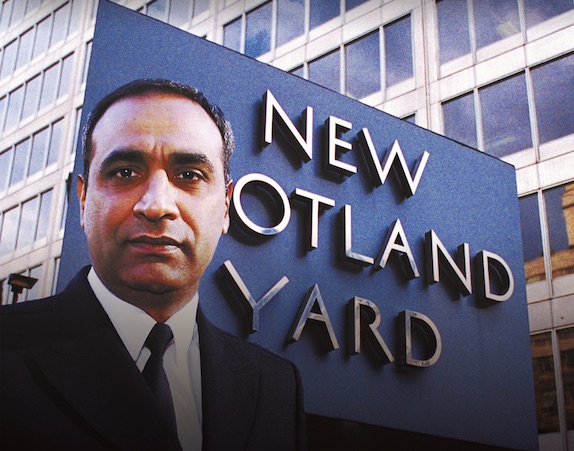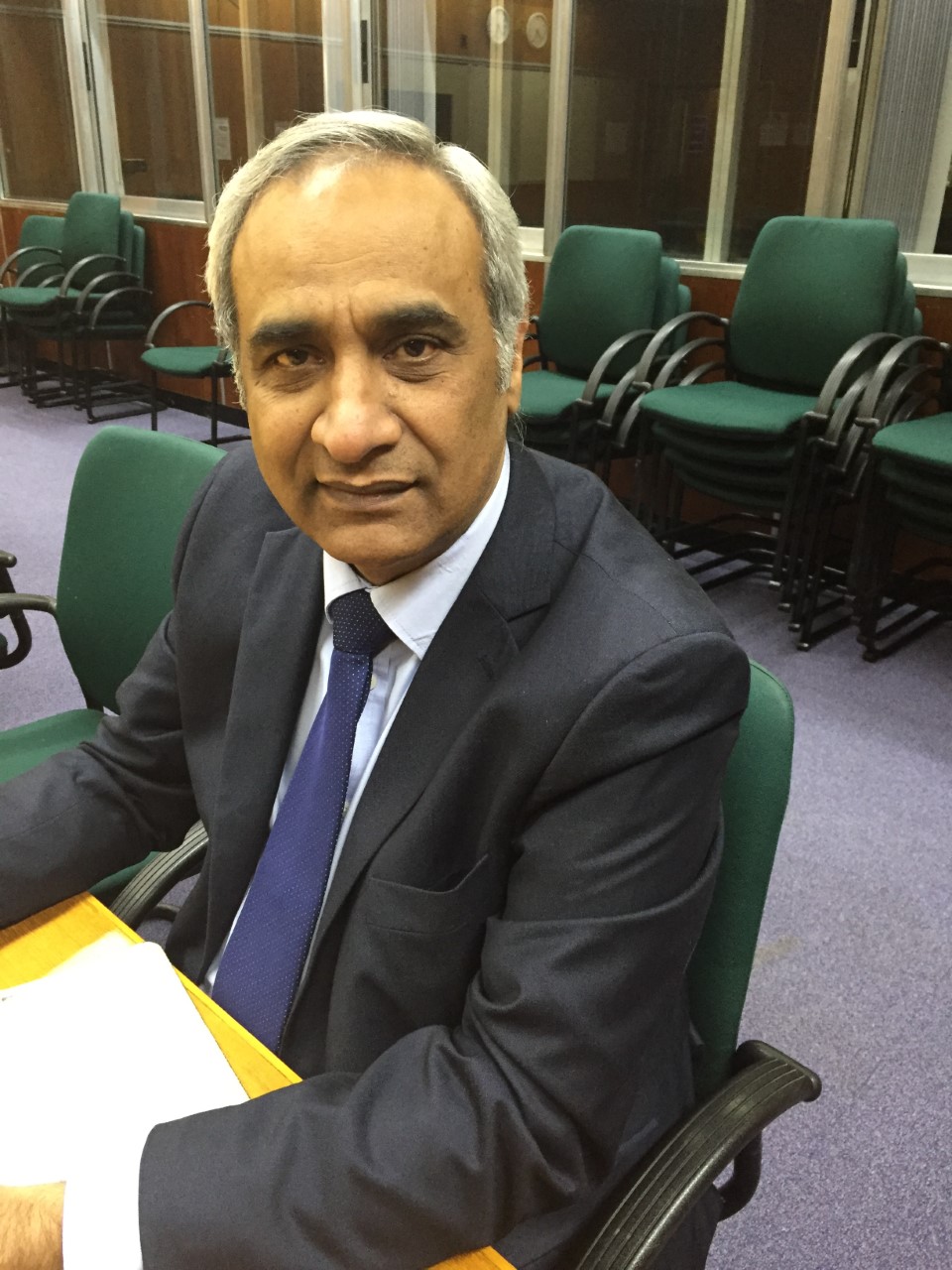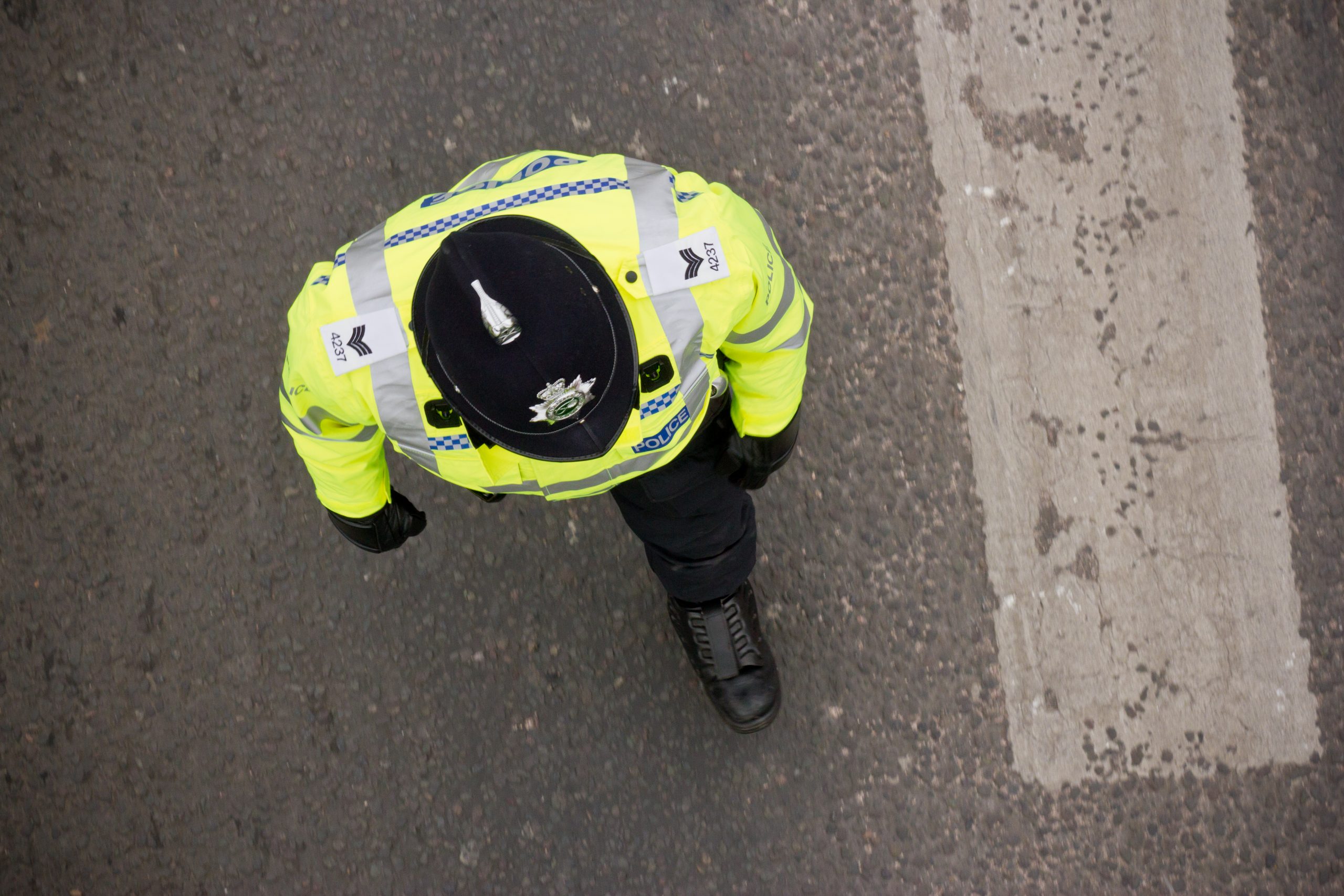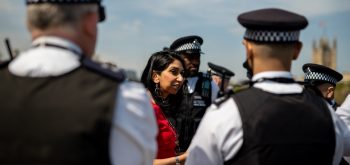In the 21st Century, there are growing numbers of turban wearing Sikhs in all fields of employment in the United Kingdom. A lot of Sikhs had to struggle and make sacrifices for the generation of Sikhs today. Gurpal Virdi on the history of the turban in the Metropolitan Police
In 1967, Herbert Wentworth Stotesbury of the Home Office wrote to the Commissioner of Metropolitan Police, Sir Joseph Simpson.
Ref: TRA/65 121/9/5
Dear Commissioner,
The Chief Constable of Birmingham has asked us whether he should allow a Sikh, who wishes to become a traffic warden in the city, to wear a turban instead of the regulation uniform cap. We are inclined to recommend to the Home Secretary that he should amend his determination of traffic wardens’ uniform to allow traffic wardens, who wish to do from religious convictions, to wear a suitable blue uniform turban with the metal distinguishing badge. We should, as usual, put the proposal first to the local authority association but it would be useful, at this stage, to know how you would view it.
It is a simple matter, in isolation, to decide that Sikh traffic wardens should be allowed to wear a turban, because this accords with practice in the armed services and in the colonial police forces. But in deciding that a turban would be suitable for a traffic warden, it is perhaps necessary to have in mind that a time may come when a Sikh applies to join the police force and asks to be allowed to wear a turban instead of a helmet. We think that we could deal with this question as a quite separate matter; and it may well be that when it arises, the recommendation which the Police Advisory Board committee on uniforms is going to make that for ordinary purpose the police uniform should be a cap instead of a helmet will make it easier to resolve.
I should be glad to know whether you share our view that we can cross the bridge of police turbans when we come to it (although it may not be too early to begin to think about how we should do so) and whether you yourself would see objection to suitable Sikh applicants for your traffic warden service wearing an appropriate uniform turban for religious reasons.
Yours sincerely
W. STOTESBURY
On 23rd November 1967, the Commissioner responded.
In reply to your letter under the above reference concerning Sikh traffic wardens my personal feeling is that it would be petty not to allow a Sikh who wished to do so to wear a turban on this duty. The presentation by the press of the row which arose in the Midlands a year or two back about bus conductors made everything look rather petty and I think we should avoid this sort of thing if we can. I am not aware of any request of this nature which has been made in London in our recruitment of wardens and I do not even know whether any Sikh has ever applied. It is possible that they have been told the conditions of service and the fact that they would have to wear caps and that somebody has withdrawn for this reason. I will do my best to find out whether this is the case and, if so, I will provide the supplementary information.
This is quite straightforward as it stands in isolation. But I am just as clear in my view about the possible extension of this to the police and in this respect I take the opposite view. Whatever the Uniform Committee may recommend to the Police advisory Board, I shall take a very strong stand on the wearing of helmets in London. I know that more and more men have got to wear caps when, for example, they drive Panda cars in the ordinary course of their duty buy I would not expect men detailed for duty in connection with demonstrations, etc. to be equipped in anything but helmets. This is necessary for protective reasons and, even more important, for identification. By that I mean identification by other officers who want to know who are police officers and where they are, often in a dense crowd and bad conditions of lighting, and equally important to ensure that the public have no doubt that a policeman is present. For this reason, if for no other, I should not want a Sikh policeman to appear under such circumstances in a turban. Even on ordinary duty I think there might be some embarrassment but I will not elaborate the arguments other than to say that I think the Police Service and significance of the uniform is very different matter from the public utility undertaking or a minor public service such as the Wardens’ service.
I realise that in the Armed Services turbans are worn under certain circumstances. Where there are mixed troops, as distinction from a Sikh Regiment, I do not know what the conditions are but I imagine that under battle conditions even the Sikh Infantryman is required to wear a steel helmet. How he does this, if in non-combative duties he wears a turban, I don’t know but we could look into this at somewhat greater leisure.
Yours sincerely
Commissioner
On 7th February 1969. Assistant Commissioner ‘D’, John Hill, writes to the Commissioner, Sir John Waldron.
Commissioner,
On other papers I am dealing with an application to join the Force from an Indian who is a Sikh, and normally wears a turban. The applicant is over normal age limit and there are other complications but these are best dealt with separately on the recruiting papers.
He has, however, raised the issue of the turban and it will be appropriate on this file to confirm or review the decision of your predecessor in his letter to Stotesbury on 23rd November 1967. The ruling now given will be given considerable importance to the Police Service and if it is against the wearing of a turban by a police officer, inevitably that decision will be contested, if not now, then on some future occasion.
There can be little doubt you may well disapprove the wearing of turbans on certain duties, e.g., whilst riding a motor cycle. But their unsuitability as headgear, except that they are not “uniform”, for wear by officers on normal foot duty is less clear. It can, for example, be argued the turban gives as much protection as the flat cap that so many of our men now wear.
On the other hand you may contend the turban provides inadequate protection, compared with the helmet, at demonstrations or when violence is feared. In this connexion even the adequacy of the helmet is questioned in some quarters.
The case is arguable, but it does seem that the wearing of the turban restricts the individual’s availability and suitability for all duties, – hitherto a pre-requisite for all entrants.
It will be unfortunate, however, if, as and when we do find suitable “immigrant” recruits for the Force, Sikhs are excluded for reasons other than their personal qualifications, or lack of same.
A.C. ‘D’
On 10th February 1969, the Commissioner, Sir John Waldron, writes to Stotesbury.
Dear Stotesbury,
Towards the end of 1967 you wrote to my predecessor to seek his opinion whether Sikhs who wished to become Traffic wardens should be allowed to wear turbans. We sent a reply on 23rd November saying that we saw no objection to this in principle but that it would be very different matter if a Sikh applied to join the Police Service. We now have an application pending and must come to some decision.
Personally I am much against it, as I would be any other peculiarity which tended to make one policeman different from another. There would be certain duties such as patrolling on a motor cycle or taking part in demonstrations where a turban would be unsuitable because it would not provide the necessary protection. Prompt recognition by police or public in a crowd is essential; this a helmet provides. It would be inconvenient if any man accepted into the Force was restricted in the duties that he was able to do. For these reasons alone I consider that anyone who joins the Service, whatever his religion, race or ethnic origin may be, must dress in the standard uniform of the Force.
In addition it might well produce strong objections from the Federation, who at the best are never anxious to accept applicants of foreign origin into the Service. There is a danger of ridicule. On the whole I think we must lay down that any man who wants to become a policeman must comply with the standard conditions.
Yours sincerely
Commissioner
On 18th April 1969, the Home Office, James Henderson Waddell, Deputy Under-Secretary, Home Office, wrote to the Commissioner, Sir John Waldron. (Waddell on retirement from the Civil Service spent four years as Deputy Chairman of the Police Complaints Board.)
Dear Commissioner,
You will remember writing to Stotesbury on 10th February about an application from a Sikh to join the force. We had a reminder on 15 April from John Hill and we have meanwhile had some word about the difficult issues raised by the application.
As I said when we met, the Home Secretary fully appreciates the considerations mentioned in your letter but has come to the conclusion that, on balance, it would be right to permit any Sikh who joins the police service to wear a turban. He had in mind particularly that, although there is a case for insisting on uniformity of dress on a uniformed and disciplined service, the fighting services have found it satisfactory to accommodate Sikhs wearing turbans; and he does not think that the special considerations which apply in the police service – including the possibility that a man wearing a turban could not be employed on every aspect of police duty would outweigh the general desirability of putting no obstacle in the way of a Sikh recruit.
I have, as promised, spoken to Osmond and Pamplin; and I believe you will yourself be seeing Pamplin and Joiner in the next few days. Their attitude was, I found, re-assuring. It really amounted to this: that, whatever views might be held on the matters of principle and practice which could be dispel? the volume of criticism which might be raised if an application from a Sikh were not accepted would make it not worthwhile to reject the application. They both said that if comment arose among their members they would do their best to support the Home Secretary’s conclusions.
Yours sincerely
Waddell
On 29th April 1969, the Commissioner writes to Waddell
Dear Waddell,
Thank you for your letter of 18th April concerning the application that we have had from a Sikh to join this force. I have now had an opportunity of having a discussion with Pamplin and Joiner and we agree that there is no alternative but to accept such applications. No doubt some members of the force will be critical but, provided the man himself rises to the occasion, any comments are not likely to be lasting. At the moment there is some doubt whether this particular applicant will join because he has held high rank in the Kenya Police service and may not be agreeable to start again from scratch.
Incidentally, our civil staff recruiting branch have provisionally accepted a Sikh (ex-Kenya Police) as a Traffic Warden.
Yours sincerely
From the Director of Personal Services (Army) the Metropolitan police received a letter dated 29th April 1969 from the Ministry of Defence giving the MET advice.
Extract from Clothing Regulations Pamphlet 4 (WO Code 13251) Para 16. Special scales of headdress read:
“(f) Turbans. Sikhs enlisted in the British Army will wear a headdress consisting of an outer turban (pagri) of cotton cloth, 6 yards long and 32 inches wide and an inner turban (pag) of similar cloth, 5 yards long and 8 inches wide. The outer turban or pagri will be of the same colour as the top of the forage cap and the inner turban or pag to be of the facing colour as shown in the Army list for the regiment or corps to which the soldier belongs. The regimental badge will be worn on the front of the head-dress.”
Internally within the MPS senior officers were unsure on how to deal with Sikhs. On 22 May 1969, a senior officer wrote the following on Sikhs:
SIKHS
Part of the Sikh religion involves conforming to a certain mode of dress – commonly known as the 5 Ks (in Hindi).
Long hair with top knot
Pagri or Turban
Bangle on wrist
Short under pants
Knife
If a Sikh insists on his turban then it is reasonable to assume that somewhere on his body he carries a knife.
Sikhism is part of the Hindu religion. To them a cow (among other things) is sacred. Would he have any restriction on English food?
Does he realise the communal life in Training School and a Section House? Would any special food (or prepared in a special way) be necessary?
Religious holidays – Hinduism has many more religious days – feast days – fast days etc. than Christians. Would he require any special days off or would there be any restrictions at all on any day throughout the year?
Would he serve alongside a Muslim i.e. Pakistani?
On Friday 23rd May 1969, a potential Sikh recruit was interviewed and below is the board’s notes (name is deleted and notes edited due to confidentiality):
A tall, slim bearded Indian wearing a dark turban, ill-fitting blazer, jumper (with shirt and tie) and slacks. He has XX years police service in Xxxx Police. Speaks very quickly. Working in a factory at present. Had to leave Xxxx Police because of Africanisation. Most service was as a detective. Told there is very little prospect of ever getting into CID and he must join as uniformed Constable with no promises of his ever being a detective. Said he understood and appreciated this. Says he is prepared to wok in uniform with a helmet and not turban if required. He states he can get a dispensation in view of the nature of the work. Does not wear a bangle or knife. Says there is no bar to his working alongside any other religions. Says he understands that he would start the same way as any now 19 year old recruit. Would be prepared to live in a block of flats of M. Q’s (Married Quarters). Whole family can speak English. Says there are no dietary problems – he will eat English food. Says he will put his duty before any religious commitments. Speech is not always easy to follow, and he has an excitable temperament. Some reservations as to character and temperament, but on balance with police experience and sporting background – accepted.
Mr XXXX, a Sikh, in his interview here on 23rd May, 1969 (see selection board notes) said that it is possible to get dispensation from wearing turbans, beards, knives, bangles and other special clothing for those men of the faith who want to be police officers.
In order to get confirmation of this statement Chief Inspector Lee A.7 (Race Relations) has been asked if there is any central Sikh authority who can be consulted. He has spoken to Mrs P. M. Wylam, Secretary of the Central Committee of the Sikhs in Great Britain and he now informs us that no such authority or dispensation exists and it is entirely up to individual concerned as to whether he retails these manifestations of his religion. Mr Lee is lunching with Mrs Wylam in July and he will obtain any further information required at that time. He also mentioned that Mrs Wylam understands that if a Sikh is accepted into the service he will be allowed to keep his turban, and it can only be assumed that this information has emanated from Home Office.
06.06.1969
On 3rd October 1969 – POLICE REVIEW ran the following article:
Blue Turbans on the Beat
The Home Secretary has confirmed that from the Home Office point of view he sees no objection to Sikhs wearing dark blue turbans on duty should any be recruited into the British Police. Up to now the Home Office knows no Police Force where Sikhs have successfully passed the stringent tests to become Policemen. Under their religious rules, Sikhs must wear turbans. The Home Secretary may insist that any Sikh recruited as traffic warden must wear yellow turbans.
Mrs P M Wylam
If you go through the 60’s photographs of almost all major Sikh functions you will see a white woman dressed in a sari, glasses and hair tied in a bun as was the Indian fashion at the time. Mrs Pamela Margaret Wylam who was the Secretary of the Central Committee of the Sikhs in Great Britain, had written three books:
- An Introduction to Sikh Belief
- The Sikh Marriage Ceremony
- Brief outline of the Sikh faith
This made her an expert on Sikh faith at the time. On 5th November 1969 her letter below was published in the Guardian newspaper:
Sikhs and the turban
Sir, – The report of the ‘Sikh’ policeman, Constable Kenth, is bound to give a mistaken impression regarding the Sikh religion, since you state that ‘he is allowed to practice his religion without wearing the turban’. In fact, he is most certainly not practicing his religion.
It should be made clear that there are two kinds of people entitled to call themselves ‘Sikh’. There are the amritdhari Sikhs who have taken the Sikh baptism and have thereby promised always to keep five symbols, including uncut hair. These always wear the turban.
Then there are the sahijdhari Sikhs who have never taken the Sikh baptism and need not wear the symbols or the long hair, beard and turban, but they still believe in the teachings of the ten Gurus. If Constable Kenth was one of these, he should have said so plainly.
On the other hand, a person who has once taken baptism, then later cuts his hair, is an apostate and he is not entitled to call himself a Sikh.
The Sikhs here have campaigned hard for the right to wear turbans, and I am aware that many official bodies in this country are making earnest efforts to accommodate to the requirements of turbaned Sikhs in their employ. It is a pity, therefore, that apostates should continue to undermine our efforts – Yours faithfully, (Mrs) P. M. Wylam
On 6th November 1969 – Chief Inspector Powell (Community Relations) and Mr Stern (Public Relations) meet with Mr G Fifer of the Anglo-Asian Publishing Company to discuss an article about Police in this country for publication in a new periodical entitled Anglo-Asian Magazine. The purpose of this new publication, according to the Editor, is ‘to encourage good communications and complete understanding between the Asian races. To promote good relations and understanding between non-Asian and Asian people in the United Kingdom. To encourage the integration of Asians in this country while still retaining their traditional culture, bringing to their notice their lawful rights available in our democracy, so that they may become a happily settled community, contributing as citizens to the well-being of the country.’
Mr Fifer’s present intention is to explain the nature, organisation, functions and purpose of the Metropolitan Police to Anglo-Asians who are unfamiliar with this side of our national life and to provide a two-way channel of communications between the Force and the Asian section of the community. He claims to have the support of Mr Cousins and the Race Relations Board.
Mr Fifer seems to be taking a particular interest in Sikhs and their employment as police officers. The recruiting policy of this Force was carefully explained to him as well as the steps taken to bring to the notice of suitably qualified immigrants the opportunities open for appointment to the Force and Cadet Corps. He asked if an article could be prepared embodying this information to appear over the name of a suitable officer in the magazine. He guaranteed that any article printed under this agreement would not appear until they had been vetted and approved by the Commissioner. On this understanding Mr Stern agreed to prepare a draft contribution about the Metropolitan Police, to include a passage about appointment and career prospects in the Force.
The matter now rests with Community Relations and Public Relations Office.
On Wednesday 28th January 1970, the TIMES reported with a picture article of Mr Harbans Singh Jabbal (centre), who is believed to be the first turbaned Sikh in Britain to wear a police uniform, on parade at East Ham, East London, yesterday, his first day as a special constable.
Coloured Police Officers and Traffic Wardens. By September 1971 there were 11 Regulars, 22 Specials, 209 Traffic Wardens and once Cadet in the Metropolitan police.
Extract from The Times, 28 April 1972
Police want coloured recruits
MR CLINTON DAVIS (Hackney Central, Lab) asked the Home Secretary how many coloured police officers were serving with the Metropolitan Police and how many were serving in 1968, 1969, 1970 and 1971.
MR MAUDLING: Twelve. Numbers serving on December 31 each year were – 1968, 3; 1969, 4; 1970, 7; and 1971, 11.
MR DAVIS: The rate of recruitment is appalling. Urgent research ought to be undertaken into why the figures are so disappointing. Recruitment into the police of coloured people might be one of the best ways of eliminating so much of the mutual suspicion that does exist between the police and the immigrant community.
MR MAULDING: I agree that the figures are disappointing. They have been at this sort of level for many years. Research would be a complicated operation. I am satisfied that chief officers of police, including the Metropolitan Police, are anxious to recruit more immigrants into the police force.
MR FOWLER (Nottingham, South, C): This is a difficult problem, but at the moment the number of police recruited reflects the number of applications made. The Metropolitan Police are anxious to recruit more immigrant policemen. Any suggestion that this shows some kind of bias in recruiting police would be wrong.
MR MAUDLING: That is right.
MRS SHIRLEY WILLIAMS (Hitchin, Lab):The figures are so low and it is so important to get good relations between the police and the immigrant community, that possibly special efforts should be made to recruit from schools with a high proportion of immigrant children.
MR MAUDLING – Special efforts are being made in the areas where there is a substantial immigrant population. I will examine her suggestion.
Mr Robert Mark’s appointment as Commissioner of the Metropolitan Police had produced a ray of hope in the difficult area of relationships between police and black people, Mr Jeff Crawford, of the North London West Indian Association, said yesterday.
He told the Select Committee on Race Relations and Immigration that he hoped that ray would not be illusionary. Mr Mark had shown that he was a politician as well as a policeman.
Mr Crawford said he had rather given up hope in the past few years and went on: ‘I was convinced that the police were doing a whitewash job and trying to prove you were wrong, misconceived, or politically misguided.’
Black leaders, he suggested would over the next year, wait and see if the reforms Mr Mark was putting forward had positive effect. The Select Committee was taking evidence about immigrant and police relations in Islington, north London.
The police memorandum of evidence said that although black youths might think the police singled them out for attention statistics of arrests and ‘stops’ failed to support that view.
Islington Committee for Community Relations stated in evidence that the police relationship with young immigrants gave rise to much concern. The youths felt that they were being harassed to the point at which the feared police. They felt they never knew when they would be picked up for some reason, genuine or not.
CHAHIL, Bhagvinder Singh
Warrant Number – 164033
Joined MPS on – 18 September 1972
A 26 year old Ugandan Asian who, in view of his religious persuasion was determined to wear a turban when on duty. Sadly he resigned whilst still at training school. Bhagvinder according to records to date was the first turban wearing Sikh regular police officer in the MET.
On 16th November 1973 – POLICE REVIEW reported:
Makhan Singh Bhogal, a traffic warden in Nottingham, is the first warden to wear a turban. It is made of dark blue material with a yellow band and a badge in front.
On 20th March 1978, Malkat Singh Chana, joined as a Traffic Warden with the Metropolitan Police. He was issued with a yellow turban but this was challenged on religious grounds and a blue one was issued. He was posted on Kensington borough.
In 1982 the Met ran a campaign to recruit more ethnic minority officers. The number of applications (not appointments) had risen from 240 in 1981 to 657 in 1982. Chief Inspector Spice said: ‘This is a great rise and it may well be that we have already creamed-off many good candidates.’
20 April 1983: The number of ethnic officers in the MPS – 186
On 10th October 1983, ex Indian army Captain, Brij Paul Singh RAJANWAL, aged 32, joined the Metropolitan police as a turban wearing Sikh regular officer. After training he was posted to Southall police station. He was the first turban wearing Sikh who survived training school and probation period. In 1985 he was awarded a Resuscitation certificate from the Royal Human Society for saving a nine year old boy. On 29th December 1993 he resigned from the MET on ill health grounds. He is currently an International Travelling Yoga teacher and Art of Living presenter. During his service he introduced the chequered band on the dark blue turban as he felt that he was not being recognised as a police officer whilst in uniform.
In Notices 7-01 of Wednesday 14 February 2001, the following instructions were given:
Male Sikhs may wear a turban, customary steel bangle and small replica dagger (Kirpan) if they wish to do so. The style of turban is a matter of personal choice but it must be neat and presentable and made of matt, dark navy blue material. Appropriate badging must be worn as required.
In Notices 28/01 of Wednesday 11 July 2001, the following instructions were given:
Police dress code and appearance – Amendment
(SS 11/00/4) (Assistant Commissioner, Policy, Review and Standards)
A review of existing policy in relation to the provision for Sikh police officers to wear turbans has taken place. Both male and female police officers who are Sikhs, may wear turbans if they choose. There will no longer be a requirement for the Service badge and chequered banding to be worn on the turban. The following amendment to the existing dress code as stated in Item 8 of Notices 7/01 of 14 February 2001 is required.
Sikh police officers may wear a turban, Kara (customary steel bangle) and a Kirpan (small replica dagger) if they wish to do so. The style of turban is a matter of personal choice but it must be neat and presentable and made of matt, dark navy blue material.
In 2010, Gurbinder Kaur Dhinsa – became the first baptised female Sikh police officer wearing a turban in the Metropolitan Police Service.







